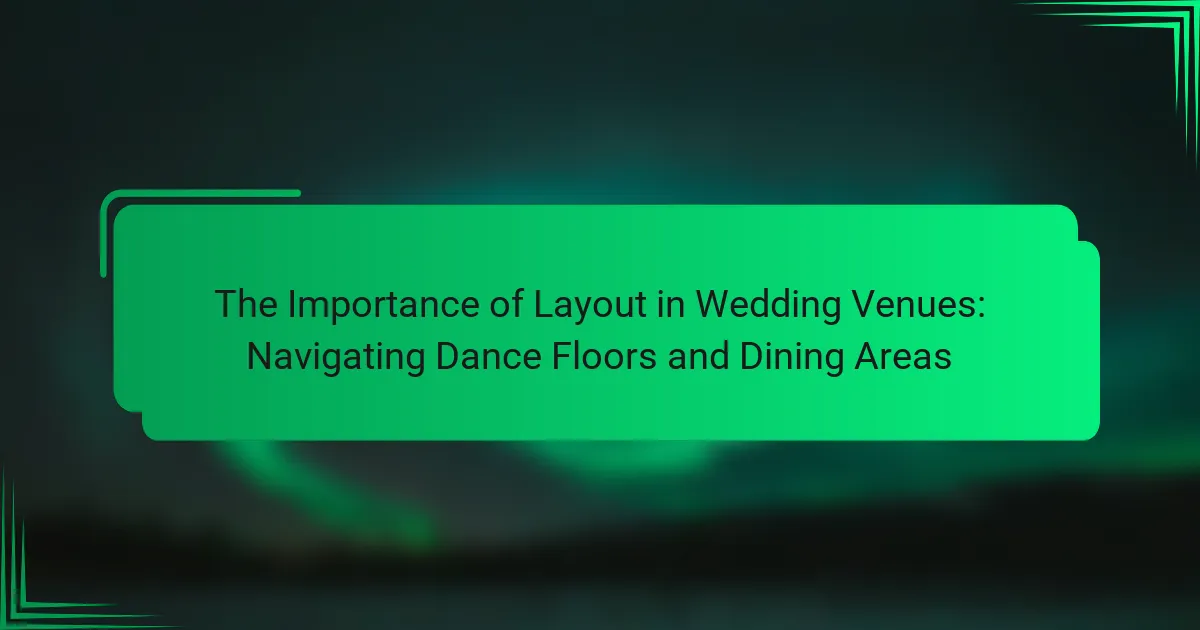The article focuses on the significance of layout in wedding venues, emphasizing how it affects event flow and guest experience. A well-planned layout enhances interaction and comfort, ensuring key areas like dining, dancing, and socializing are accessible. It highlights the relationship between dance floors and dining areas, noting that proximity can influence guest participation and satisfaction. Strategies for optimizing venue layout include clear pathways, central bar placement, and thoughtful seating arrangements, all aimed at improving the overall atmosphere and organization of the event.

Why is Layout Important in Wedding Venues?
Layout is important in wedding venues because it directly influences the flow of the event. A well-planned layout enhances guest interaction and comfort. It ensures that essential areas like dining, dancing, and socializing are easily accessible. Proper spacing prevents overcrowding and allows for smooth movement. Studies show that a functional layout can improve guest satisfaction. For instance, a survey from The Knot found that 70% of couples prioritize venue layout in their planning. An effective layout can also enhance the aesthetic appeal of the venue. This creates a memorable experience for guests.
How does layout influence the overall wedding experience?
The layout significantly influences the overall wedding experience by affecting guest flow and interaction. A well-planned layout facilitates smooth movement between areas like dining and dancing. This encourages guests to mingle and engage with one another. Conversely, a poorly designed layout can create bottlenecks and hinder socialization. For example, placing the dance floor too far from dining areas may discourage guests from participating in both activities. Studies indicate that effective space design can enhance guest satisfaction by up to 30%. Therefore, thoughtful layout decisions are crucial for a memorable wedding experience.
What role does layout play in guest comfort and flow?
Layout significantly influences guest comfort and flow at wedding venues. A well-planned layout enhances movement and accessibility. It ensures that guests can easily navigate between dining areas and dance floors. Comfortable spacing between tables prevents overcrowding. This arrangement allows for social interaction while maintaining personal space. Clear pathways reduce congestion during peak times, such as meal service or dancing. Research shows that effective layouts can improve overall guest satisfaction. A study by the Journal of Hospitality Management indicates that well-designed spaces lead to higher comfort levels. Thus, layout is crucial for optimizing guest experience at weddings.
How can layout impact the atmosphere of the event?
The layout significantly impacts the atmosphere of an event. A well-planned layout enhances guest interaction and engagement. For example, open spaces encourage mingling, while segmented areas can create intimacy. The arrangement of seating influences comfort and accessibility. A dance floor positioned centrally invites participation. Additionally, the flow of movement affects how guests experience the event. Research shows that layouts designed for social interaction result in higher satisfaction rates among attendees. Thus, the layout is crucial for shaping the overall mood and experience of the event.
What are the key elements of a wedding venue layout?
The key elements of a wedding venue layout include space allocation, flow, and functionality. Space allocation involves designating areas for the ceremony, reception, dining, and dancing. Flow ensures that guests can move easily between these areas without congestion. Functionality refers to the practical use of space, such as seating arrangements and accessibility. Proper layout enhances guest experience and promotes interaction. Studies show that well-planned layouts can increase guest satisfaction by up to 30%.
What considerations are essential for dance floor placement?
Essential considerations for dance floor placement include space, visibility, and accessibility. The dance floor should be large enough to accommodate the expected number of guests. It should be positioned where it is easily visible to all attendees. This enhances the overall experience and encourages participation. Accessibility is crucial; the floor should be placed near exits and restrooms. Additionally, consider the proximity to dining areas to facilitate a smooth transition between eating and dancing. Lighting and sound should also be optimized in the dance floor area to enhance the ambiance. These factors collectively ensure a successful and enjoyable event.
How should dining areas be arranged for optimal interaction?
Dining areas should be arranged in a way that encourages conversation and connection among guests. Round tables facilitate better interaction compared to long rectangular tables. This shape allows guests to see and engage with everyone at the table easily. Placement should also consider spacing; tables should be close enough to encourage conversation but far enough to allow movement.
Creating a central focal point, like a buffet or dessert station, can draw guests together. Additionally, consider incorporating lounge areas with comfortable seating for informal conversations. The arrangement should allow for easy navigation without obstructing pathways.
Research by the American Society of Interior Designers indicates that layout significantly impacts social interaction in event spaces. A well-thought-out dining area layout enhances guest experience and fosters connections.

How do Dance Floors and Dining Areas Interact in Wedding Venues?
Dance floors and dining areas interact in wedding venues by influencing guest movement and overall experience. The layout must facilitate easy transition between dining and dancing. A well-placed dance floor encourages guests to participate in festivities. Proximity to dining areas can enhance engagement during the event. For example, guests are more likely to dance if food is nearby. Conversely, a distant dance floor may discourage participation. Effective layouts also minimize noise disruption from the dance area to dining spaces. This balance creates a harmonious atmosphere for all attendees.
What are the best practices for integrating dance floors and dining areas?
The best practices for integrating dance floors and dining areas include strategic layout design and clear spatial separation. A well-defined space should allow for easy movement between dining and dancing. Use flexible furniture arrangements to facilitate transitions. Consider sound management to balance music volume with dining conversations. Ensure adequate lighting to create an inviting atmosphere for both areas. Incorporate visual cues, such as decor or signage, to guide guests. Research shows that effective layout enhances guest experience and encourages participation. A study by the Journal of Hospitality and Tourism Research indicates that well-integrated spaces can increase event satisfaction by up to 30%.
How can the proximity of these areas affect guest engagement?
Proximity of areas in wedding venues significantly affects guest engagement. When dining areas are close to dance floors, guests are more likely to interact with each other. This arrangement encourages movement between eating and dancing, fostering a lively atmosphere. Research indicates that spatial layout influences social interaction. A study by Evans et al. (2019) found that guests in closer proximity reported higher levels of engagement and enjoyment. Additionally, easy access to amenities keeps guests involved in activities. Therefore, thoughtful layout design enhances overall guest experience at weddings.
What layout strategies can enhance transitions between dining and dancing?
Flexible space planning enhances transitions between dining and dancing. Utilizing movable furniture allows for quick reconfiguration. Designating clear pathways facilitates smooth movement between areas. Incorporating multi-functional spaces supports both dining and dancing activities. Using visual cues, like lighting changes, signals transitions effectively. Strategic placement of dance floors near dining areas reduces distance. Open layouts promote an inviting atmosphere for guests. Research indicates that well-designed layouts improve guest flow and satisfaction.
Why is it crucial to consider traffic flow in wedding venue layouts?
Considering traffic flow in wedding venue layouts is crucial for guest comfort and safety. Effective traffic flow minimizes congestion and allows guests to move freely. This enhances the overall experience during key moments, such as dining and dancing. Studies show that well-planned layouts can reduce wait times and improve guest satisfaction. For instance, venues with clear pathways report higher enjoyment levels. Additionally, a smooth flow can prevent accidents, such as spills or collisions. Therefore, thoughtful design directly impacts the event’s success and guest enjoyment.
What are the potential issues with poor traffic flow?
Poor traffic flow can lead to several significant issues in wedding venues. It may cause congestion, making it difficult for guests to move freely. This can result in delays during key moments, such as the ceremony or reception. Guests might feel frustrated or uncomfortable due to the lack of space. Poorly designed layouts can also impede access to essential areas like restrooms and dining spaces. Additionally, safety hazards may arise if emergency exits are obstructed. Studies show that effective venue layout enhances guest experience and satisfaction. Therefore, optimizing traffic flow is crucial for successful events.
How can effective traffic flow improve the guest experience?
Effective traffic flow enhances the guest experience by minimizing congestion and facilitating movement. When guests can navigate easily, they feel more comfortable and engaged. A well-planned layout allows for smooth transitions between areas such as dining and dancing. This reduces wait times and frustration during peak moments, like meal service or dancing. Studies show that venues with effective traffic flow report higher satisfaction rates among guests. For example, a survey by Eventbrite found that 78% of attendees appreciated easy access to different areas of an event. Improved traffic flow also encourages social interaction, as guests can move freely and connect with others. Overall, effective traffic flow contributes significantly to a positive and memorable experience.

What Tips Can Help Optimize Wedding Venue Layout?
To optimize wedding venue layout, prioritize the flow of guests. Ensure clear pathways between dining areas and dance floors. Place the bar centrally to encourage mingling. Arrange seating to facilitate conversation while considering sightlines to the main events. Use signage to guide guests effectively throughout the venue. Consider the acoustics to enhance music and speeches. Ensure adequate space for dancing to avoid overcrowding. These strategies improve guest experience and event organization.
How can couples and planners create an effective layout plan?
Couples and planners can create an effective layout plan by prioritizing flow and accessibility. They should start by assessing the venue’s dimensions and features. Mapping out key areas like the dance floor and dining space is essential. Couples should consider guest movement patterns during the event. Ensuring that pathways are clear helps avoid congestion. Planners can use seating charts to optimize guest placements. Including space for entertainment and activities enhances the experience. Additionally, feedback from previous events can inform layout decisions. A well-thought-out layout fosters a welcoming atmosphere and encourages guest interaction.
What tools and resources are available for layout design?
Layout design tools include software and resources that help visualize and plan space effectively. Popular tools are AutoCAD, SketchUp, and Adobe InDesign. These programs allow users to create detailed floor plans and 3D models. Resources like online templates and layout guides are also available. Websites such as Pinterest offer inspiration for layout ideas. Additionally, event planning platforms provide customizable layouts for wedding venues. These tools enhance the efficiency of designing functional spaces for dining and dancing.
How can feedback from previous events inform layout decisions?
Feedback from previous events can significantly inform layout decisions for future gatherings. It provides insights into guest flow and interaction. For example, feedback may reveal that seating arrangements hinder movement. This data can lead to more open dining areas. Additionally, comments about dance floor placement can enhance visibility and accessibility. Analyzing past event layouts helps identify successful configurations. It allows planners to optimize space for comfort and engagement. Ultimately, leveraging feedback enhances overall guest experience and satisfaction.
What common mistakes should be avoided in wedding venue layout?
Common mistakes to avoid in wedding venue layout include poor flow and accessibility. Ensuring guests can easily navigate between areas is crucial. A cluttered space can hinder movement and create discomfort. Additionally, neglecting to designate clear areas for dining and dancing can lead to chaos. Overlooking the placement of key elements, such as the bar or restrooms, can disrupt guest experience. Ignoring sightlines may prevent guests from enjoying important moments. Lastly, failing to consider the venue’s acoustics can impact sound quality during speeches and music. These mistakes can significantly affect the overall enjoyment of the event.
How can inadequate spacing impact the event?
Inadequate spacing can significantly impact the event’s flow and guest experience. Limited space can lead to overcrowding, making movement difficult. Guests may feel uncomfortable or frustrated in cramped areas. This can hinder social interactions and reduce overall enjoyment. For example, a narrow dance floor can restrict dancing and limit participation. Insufficient dining area space can lead to longer wait times for food and drinks. According to event planning studies, optimal spacing enhances guest satisfaction and engagement. Proper layout design is essential for a successful event atmosphere.
What layout pitfalls can lead to a disjointed experience?
Poor layout design can lead to a disjointed experience at wedding venues. Inadequate spacing between dining and dance areas can disrupt flow. Guests may feel cramped or isolated if seating is poorly arranged. Misalignment of focal points, such as the dance floor or stage, can confuse guests. Lack of clear pathways may hinder movement and create congestion. Insufficient lighting can also contribute to a disjointed atmosphere. These pitfalls can detract from the overall enjoyment of the event. A well-planned layout enhances guest interaction and engagement.
The main entity of this article is the layout of wedding venues, focusing on the interaction between dance floors and dining areas. The article emphasizes the importance of a well-planned layout in enhancing guest comfort, flow, and overall experience during weddings. Key topics include the impact of layout on guest interaction, optimal placement of dining and dance areas, strategies for effective transitions, and common mistakes to avoid in venue design. Research findings highlight that thoughtful layout decisions can significantly improve guest satisfaction and engagement at wedding events.
